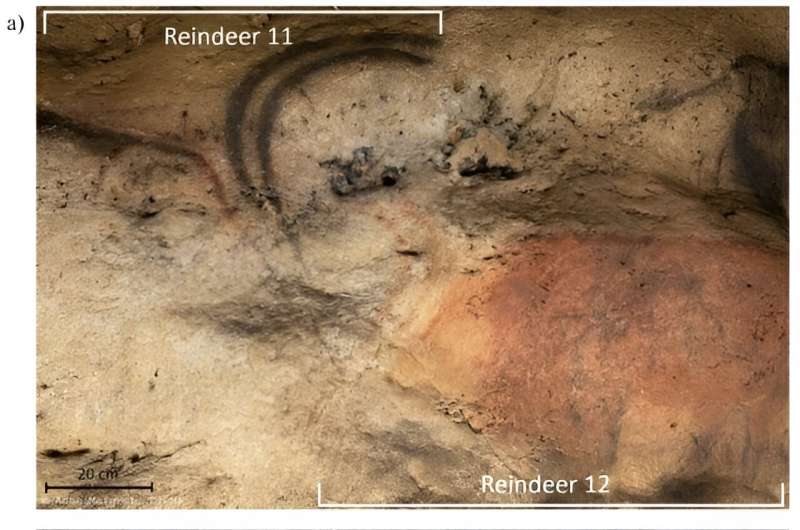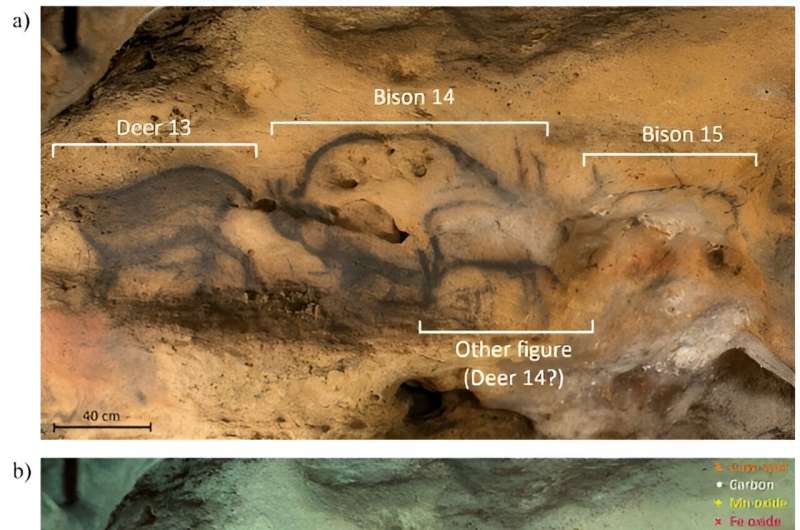December 18, 2023 feature
This article has been reviewed according to Science X's editorial process and policies. Editors have highlighted the following attributes while ensuring the content's credibility:
fact-checked
peer-reviewed publication
trusted source
proofread
First discovery of carbon-based cave art in France's Dordogne region could pave way for precise radiocarbon dating

The Dordogne region of southern France is home to over 200 caves decorated with colorful Paleolithic art, but little is known about how old it is. Due to its coloration with iron- or manganese-oxide-based material, radiocarbon dating of the art has not been possible, and it has been generally thought to have been created during the Magdalenian Period, which occurred between 12,000 and 17,000 years ago.
Now, a research team from the Center de Recherche et de Restauration des Musées de France has reported the first discovery of black carbon-based art in Dordogne's Font-de-Gaume cave, portending new opportunities for both radiocarbon dating and reevaluation of existing art in this cave and others throughout the region.
The team's findings, titled "First discovery of charcoal-based prehistoric cave art in Dordogne," are published in Scientific Reports.
In late February 2020, the team discovered the charcoal-based drawings in the cave's main galleries. The cave is informally known as "Bison Cave" owing to its 80 depictions of bison, along with others of deer, horses, mammoths, and other images. Animals comprise approximately two-thirds of all the Font-de-Gaume cave's art, with tectiforms representing the remaining third.
While some of the bison are depicted in two or more shades including ranges of black to brown and red to yellow, others are done primarily in black and red, or only black. In 1902, Henri Moissan—who won the 1906 Nobel Prize in Chemistry—used coloring matter samples from the art to determine components of iron and manganese oxide. However, the Font-De-Gaume cave is now a protected UNESCO World Heritage site, and only in very rare cases is sampling by authorities permitted.

Non-invasive analytical methods
Because of this, researchers have turned to non-invasive analytical methods. The researchers in this study used both visible-light and infrared photography, superimposition of the visible-light and infrared images, portable X-ray fluorescence (pXRF) and portable micro-Raman spectroscopy to generate their data. These methods revealed carbon-based drawings beneath others known to have been created with pigments of iron and manganese oxide.
By superimposing visible-light and infrared images captured from the same vantage point, the team created false color infrared photography (FCIR) images. The camera and filter they used to capture the infrared images permitted radiation wavelength only above 900 nm. Using software to combine these with green and red layers of visible-light images generated FCIR images and enabled differentiation of various materials used in the creation of the images.
The use of micro-Raman spectroscopy allowed the team to detect carbon-based compounds within the images, as well as to identify specific mineralogical phases of the iron and manganese oxide-based pigments. This spectroscopy method also made it possible to identify images specifically created with charcoal-black-based compounds as opposed to other carbon-based materials.
Using pXRF, meanwhile, allowed the researchers to differentiate among various kinds of manganese-oxide compounds in the black figures.
Regional differences and similarities
The team observes that the varying kinds of pigment materials may represent "different creation phases according to observations in other comparable decorated caves" within the Dordogne region, including the well-known Lascaux cave, discovered in 1940. The basis of the manganese-oxide pigment used in Lascaux's depictions is cryptomelane, while the Mn-O colorations of Font-de-Gaume are based in romanechite and pyrolusite.
In addition, the paper notes that similarities exist between the black pigment used in drawings in the caves at Font-de-Gaume and nearby Rouffignac.
Looking ahead, the discovery of charcoal-based figures in the Font-de-Gaume cave heralds new opportunities for specific radiocarbon dating, improvement of creation phase knowledge, and perhaps even precise inter-regional comparison.
More information: Ina Reiche et al, First discovery of charcoal-based prehistoric cave art in Dordogne, Scientific Reports (2023). DOI: 10.1038/s41598-023-47652-1
Journal information: Scientific Reports
© 2023 Science X Network



















